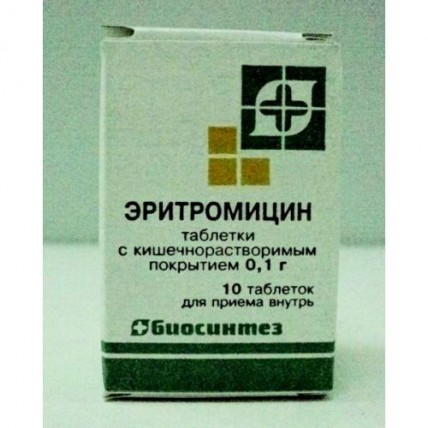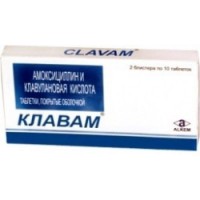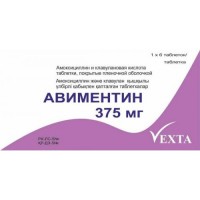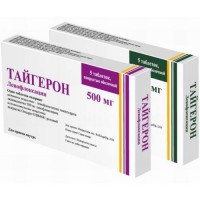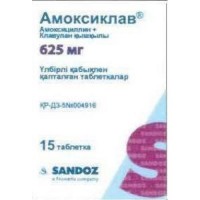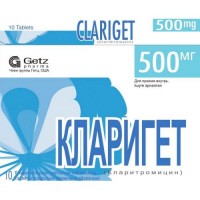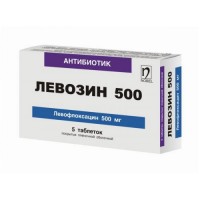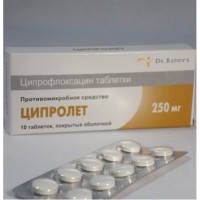Erythromycin 100 mg, 10 coated tablets
- $3.20
Out Of Stock
The instruction for use
of medicine for experts
ERYTHROMYCIN
the Trade name
Erythromycin
the International unlicensed
name Erythromycin Dosage Form
of the Tablet with a kishechnorastvorimy covering, 0.1 and 0.25 g
Structure
One tablet contains
active agent – erythromycin 0.1170 g and 0.2924 g, equivalent to 0.1 g and
0.25 g of pure substance,
excipients: potato starch, polyvinylpirrolidone, twin-80, calcium stearate,
structure of a cover: atsetilftaliltselyuloza, castor oil, dioxide of the titan.
The description
of the Tablet biconvex, color, white or white with a grayish shade,
Pharmacotherapeutic group
Antimicrobial drugs for system use. Macroleads
the Code of automatic telephone exchange J01FA01
the Pharmacological
Pharmacokinetics Eritromitsin properties is well soaked up at intake. Meal does not influence the oral forms of erythromycin in the form of the basis covered with a kishechnorastvorimy cover. Bioavailability - 30-65%. The maximum concentration (Cmax) is reached after intake in 2-4 h. The affinity to proteins of blood plasma high, communicates for 70 – 80%.
In an organism it is distributed unevenly. In large numbers collects in a liver, a spleen, kidneys. In bile and urine the concentration exceeds concentration in plasma ten times. Well gets into tissues of lungs, lymph nodes, exudate of a middle ear, a prostate secret, sperm, a pleural cavity, ascitic and synovial liquids. Milk of the feeding women contains 50% of concentration in plasma. Badly gets through a blood-brain barrier, into cerebrospinal fluid (its concentration makes 10% of drug content in plasma). At inflammatory processes in brain covers, their permeability for erythromycin increases a little. Gets through a placental barrier and comes to fruit blood where its contents reaches 5-20% of content in mother's plasma.
It is metabolized in a liver (more than 90%), partially with formation of inactive metabolites. Elimination half-life (T1/2) – 1.4-2 h, at an anury - 4-6 h. Removal with bile - 20-30% in not changed look, kidneys (in not changed look) - 2-5%.
A pharmacodynamics
the Bacteriostatic antibiotic from group of macroleads. However in high doses concerning sensitive microorganisms has bactericidal effect. Erythromycin reversibly contacts ribosomes of bacteria, suppressing thereby protein synthesis. The spectrum of action includes gram-positive (Staphylococcus spp. which are producing and not producing penicillinase), Streptococcus spp. (including Streptococcus pneumoniae) and gram-negative microorganisms (Neisseria gonorrhoeae, Haemophilus influenzae, Bordetella pertussis, Brucella spp., Legionella spp.), e, Bacillus anthracis, Corynebacterium diphtheriae Mycoplasma spp., Chlamydia spp., Treponema spp., Ricketsia spp. Gram-negative sticks are steady: Escherichia coli, Pseudomonas aeruginosa and also Shigella spp., Salmonella spp., etc.
Indications
- diphtheria (including a bacteriocarrier), whooping cough (including prevention), trachoma, a brucellosis, a disease of legionaries, an erythrasma, listeriosis, scarlet fever, amoebic dysentery
- primary syphilis (at patients with an allergy to penicillin), uncomplicated clamidiosis at adults (with localization in lower parts of urinogenital ways and a rectum), gonorrhea
- the urinogenital infections at pregnant women caused by Chlamydia trachomatis
- conjunctivitis of newborns
- tonsillitis, otitis, sinusitis
- cholecystitis
- tracheitis, bronchitis, pneumonia, pneumonia at children
- pustulous diseases of skin, including youthful eels, contaminated wounds, decubituses, burns of the II-III St, trophic ulcers
- infections of a mucous membrane of eyes
- prevention of exacerbations of a streptococcal infection at patients with rheumatism
- preoperative preparation of intestines, dental interventions, endoscopy
- prevention of infectious complications at patients with heart diseases.
A route of administration and doses
Inside for 1-1.5 h to food. The single dose for adults and teenagers is more senior than 14 years 0.25-0.5 g. An average daily dose for adult 1-2 g in 2-4 receptions, the maximum daily dose - 4 g.
To children from 4 months to 14 years depending on age, body weight and weight of an infection on 30-50 mg/kg/days in 4 receptions (is more rare in 2 receptions at an interval of 12 h), to children of the first 3 months of life of 20-40 mg/kg/days. In case of heavy infections the dose can be doubled.
For treatment of diphtheritic carriage on 0.25 g 2 times a day.
A course dose for treatment of primary syphilis of 30-40 g, duration of treatment of 10-15dny.
In amoebic dysentery the adult on 0.25 g 4 times a day, to children – on 30-50 mg/kg/days within 10-14 days.
In gonorrhea on 0.5 g each 6 h within 3 days, further on 0.25 g each 6 h within 7 days.
The adult for prevention of a streptococcal infection (tonsillitis, pharyngitis) of 20-50 mg/kg/days, to children – 20-30 mg/kg/days, duration of a course is not less than 10 days.
For preoperative preparation of intestines for the purpose of prevention of infectious complications inside on 1 g for 19 h, 18 h and 9 h prior to operation (only 3 g).
For prevention of a septic endocarditis at patients with heart diseases on 1 g for adults and on 20 mg/kg for children, for 1 h prior to a medical or diagnostic procedure, further on 0.5 g for adults and 10 mg kg for children, repeatedly in 6 h.
In whooping cough – 40-50 mg/kg/days within 5-14 days.
The adult in uncomplicated clamidiosis and intolerance of tetracyclines – on 0.5 g 4 times a day not less than 7 days
Side effects
- abnormal liver functions, abdominal pains, cholestatic jaundice, a pseudomembranous coloenteritis, nausea, vomiting, a gastralgia, tenesmus, diarrhea, pancreatitis, dysbacteriosis
- increase in activity of hepatic transaminases
- decrease in hearing and/or sonitus
- urticaria, other forms of rash, an eosinophilia, an acute anaphylaxis
- tachycardia, blinking and/or an atrial flutter (patients with the extended interval have QT on the ECG)
- oral cavity candidiasis.
Contraindications
- hypersensitivity to drug
- liver diseases
- a concomitant use of a terfenadin or an astemizol.
Medicinal interactions
the Drugs blocking canalicular secretion extend erythromycin T1/2. It is incompatible with lincomycin, clindamycin and chloramphenicol (antagonism). Reduces bactericidal action beta laktamnykh antibiotics (penicillin, cephalosporins, karbopenema). Increases theophylline content. At a concomitant use with drugs which metabolism is carried out in a liver (carbamazepine, valproic acid, hexobarbital, Phenytoinum, an alfentanil, Disopyramidum, a lovastatin, Bromocriptinum) the concentration of these drugs in plasma can increase (is inhibitor of microsomal enzymes of a liver). Increases nephrotoxicity of cyclosporine (especially at patients with the accompanying renal failure). Reduces clearance of a triozolam and midazolam in this connection can enhance pharmacological effects of benzodiazepines. At a concomitant use with terfenadiny or astemizoly a possibility of development of arrhythmia, with dihydroergotamine or not hydrogenated ergot alkaloids vasoconstriction to a spasm, a dizesteziya. Slows down elimination (enhances effect) Methylprednisolonum, a felodipin and anticoagulants of a coumarinic row. At joint appointment with lovastatiny the rhabdomyolysis amplifies. Increases bioavailability of digoxin. Reduces efficiency of hormonal contraception.
Special instructions
At long therapy it is necessary to exercise control of laboratory indicators of function of a liver. Symptoms of cholestatic jaundice can develop in several days after the beginning of therapy, however risk of development increases after 7-14 days of continuous therapy. The likelihood of development of ototoksichesky effect is higher at patients with a renal and renal failure. Some resistant strains of Haemophilus influenzae are sensitive to a concomitant use of erythromycin and streptocides. Can interfere with definition of catecholamines in urine and activity of hepatic transaminases in blood (colorimetric definition by means of a definilgidrazin). It is impossible to wash down with milk or dairy products. The drugs increasing acidity of gastric juice and acid drinks inactivate erythromycin (except for a dosage form in the form of capsules)
Pregnancy and a lactation
At use of erythromycin at pregnancy it is necessary to estimate expected advantage for mother and potential risk for a fruit. In need of use in the period of a lactation it is necessary to resolve an issue of the breastfeeding termination.
Influence on ability to run transport and potentsialnoopasny mechanisms
Drug does not affect ability to run transport and potentsialnoopasny mechanisms.
Overdose
Symptoms: nausea, diarrhea, discomfort in a stomach, acute pancreatitis benign, dizziness (especially at patients with a liver or renal failure).
Treatment: activated carbon, careful control of a condition of a respiratory system (if necessary carrying out artificial ventilation of the lungs), acid-base balance and electrolytic exchange. Gastric lavage is effective at reception of the dose fivefold exceeding average therapeutic. The hemodialysis, peritoneal dialysis, an artificial diuresis are ineffective.
A form of release and packing
of the Tablet with a kishechnorastvorimy covering on 0.1 and 0.25 g, No. 10 in banks of orange glass. Each can together with the instruction for use is placed in a cardboard pack.
To Store storage conditions in the dry place, at a temperature no more than +25 °C.
To store out of children's reach!
The expiration date
After an expiration date drug should not be used 2 years.
Prescription status
According to the prescription
JSC Biosintez Producer,
Russia 440033, Penza, Druzhby St., 4.
To develop
of medicine for experts
ERYTHROMYCIN
the Trade name
Erythromycin
the International unlicensed
name Erythromycin Dosage Form
of the Tablet with a kishechnorastvorimy covering, 0.1 and 0.25 g
Structure
One tablet contains
active agent – erythromycin 0.1170 g and 0.2924 g, equivalent to 0.1 g and
0.25 g of pure substance,
excipients: potato starch, polyvinylpirrolidone, twin-80, calcium stearate,
structure of a cover: atsetilftaliltselyuloza, castor oil, dioxide of the titan.
The description
of the Tablet biconvex, color, white or white with a grayish shade,
Pharmacotherapeutic group
Antimicrobial drugs for system use. Macroleads
the Code of automatic telephone exchange J01FA01
the Pharmacological
Pharmacokinetics Eritromitsin properties is well soaked up at intake. Meal does not influence the oral forms of erythromycin in the form of the basis covered with a kishechnorastvorimy cover. Bioavailability - 30-65%. The maximum concentration (Cmax) is reached after intake in 2-4 h. The affinity to proteins of blood plasma high, communicates for 70 – 80%.
In an organism it is distributed unevenly. In large numbers collects in a liver, a spleen, kidneys. In bile and urine the concentration exceeds concentration in plasma ten times. Well gets into tissues of lungs, lymph nodes, exudate of a middle ear, a prostate secret, sperm, a pleural cavity, ascitic and synovial liquids. Milk of the feeding women contains 50% of concentration in plasma. Badly gets through a blood-brain barrier, into cerebrospinal fluid (its concentration makes 10% of drug content in plasma). At inflammatory processes in brain covers, their permeability for erythromycin increases a little. Gets through a placental barrier and comes to fruit blood where its contents reaches 5-20% of content in mother's plasma.
It is metabolized in a liver (more than 90%), partially with formation of inactive metabolites. Elimination half-life (T1/2) – 1.4-2 h, at an anury - 4-6 h. Removal with bile - 20-30% in not changed look, kidneys (in not changed look) - 2-5%.
A pharmacodynamics
the Bacteriostatic antibiotic from group of macroleads. However in high doses concerning sensitive microorganisms has bactericidal effect. Erythromycin reversibly contacts ribosomes of bacteria, suppressing thereby protein synthesis. The spectrum of action includes gram-positive (Staphylococcus spp. which are producing and not producing penicillinase), Streptococcus spp. (including Streptococcus pneumoniae) and gram-negative microorganisms (Neisseria gonorrhoeae, Haemophilus influenzae, Bordetella pertussis, Brucella spp., Legionella spp.), e, Bacillus anthracis, Corynebacterium diphtheriae Mycoplasma spp., Chlamydia spp., Treponema spp., Ricketsia spp. Gram-negative sticks are steady: Escherichia coli, Pseudomonas aeruginosa and also Shigella spp., Salmonella spp., etc.
Indications
- diphtheria (including a bacteriocarrier), whooping cough (including prevention), trachoma, a brucellosis, a disease of legionaries, an erythrasma, listeriosis, scarlet fever, amoebic dysentery
- primary syphilis (at patients with an allergy to penicillin), uncomplicated clamidiosis at adults (with localization in lower parts of urinogenital ways and a rectum), gonorrhea
- the urinogenital infections at pregnant women caused by Chlamydia trachomatis
- conjunctivitis of newborns
- tonsillitis, otitis, sinusitis
- cholecystitis
- tracheitis, bronchitis, pneumonia, pneumonia at children
- pustulous diseases of skin, including youthful eels, contaminated wounds, decubituses, burns of the II-III St, trophic ulcers
- infections of a mucous membrane of eyes
- prevention of exacerbations of a streptococcal infection at patients with rheumatism
- preoperative preparation of intestines, dental interventions, endoscopy
- prevention of infectious complications at patients with heart diseases.
A route of administration and doses
Inside for 1-1.5 h to food. The single dose for adults and teenagers is more senior than 14 years 0.25-0.5 g. An average daily dose for adult 1-2 g in 2-4 receptions, the maximum daily dose - 4 g.
To children from 4 months to 14 years depending on age, body weight and weight of an infection on 30-50 mg/kg/days in 4 receptions (is more rare in 2 receptions at an interval of 12 h), to children of the first 3 months of life of 20-40 mg/kg/days. In case of heavy infections the dose can be doubled.
For treatment of diphtheritic carriage on 0.25 g 2 times a day.
A course dose for treatment of primary syphilis of 30-40 g, duration of treatment of 10-15dny.
In amoebic dysentery the adult on 0.25 g 4 times a day, to children – on 30-50 mg/kg/days within 10-14 days.
In gonorrhea on 0.5 g each 6 h within 3 days, further on 0.25 g each 6 h within 7 days.
The adult for prevention of a streptococcal infection (tonsillitis, pharyngitis) of 20-50 mg/kg/days, to children – 20-30 mg/kg/days, duration of a course is not less than 10 days.
For preoperative preparation of intestines for the purpose of prevention of infectious complications inside on 1 g for 19 h, 18 h and 9 h prior to operation (only 3 g).
For prevention of a septic endocarditis at patients with heart diseases on 1 g for adults and on 20 mg/kg for children, for 1 h prior to a medical or diagnostic procedure, further on 0.5 g for adults and 10 mg kg for children, repeatedly in 6 h.
In whooping cough – 40-50 mg/kg/days within 5-14 days.
The adult in uncomplicated clamidiosis and intolerance of tetracyclines – on 0.5 g 4 times a day not less than 7 days
Side effects
- abnormal liver functions, abdominal pains, cholestatic jaundice, a pseudomembranous coloenteritis, nausea, vomiting, a gastralgia, tenesmus, diarrhea, pancreatitis, dysbacteriosis
- increase in activity of hepatic transaminases
- decrease in hearing and/or sonitus
- urticaria, other forms of rash, an eosinophilia, an acute anaphylaxis
- tachycardia, blinking and/or an atrial flutter (patients with the extended interval have QT on the ECG)
- oral cavity candidiasis.
Contraindications
- hypersensitivity to drug
- liver diseases
- a concomitant use of a terfenadin or an astemizol.
Medicinal interactions
the Drugs blocking canalicular secretion extend erythromycin T1/2. It is incompatible with lincomycin, clindamycin and chloramphenicol (antagonism). Reduces bactericidal action beta laktamnykh antibiotics (penicillin, cephalosporins, karbopenema). Increases theophylline content. At a concomitant use with drugs which metabolism is carried out in a liver (carbamazepine, valproic acid, hexobarbital, Phenytoinum, an alfentanil, Disopyramidum, a lovastatin, Bromocriptinum) the concentration of these drugs in plasma can increase (is inhibitor of microsomal enzymes of a liver). Increases nephrotoxicity of cyclosporine (especially at patients with the accompanying renal failure). Reduces clearance of a triozolam and midazolam in this connection can enhance pharmacological effects of benzodiazepines. At a concomitant use with terfenadiny or astemizoly a possibility of development of arrhythmia, with dihydroergotamine or not hydrogenated ergot alkaloids vasoconstriction to a spasm, a dizesteziya. Slows down elimination (enhances effect) Methylprednisolonum, a felodipin and anticoagulants of a coumarinic row. At joint appointment with lovastatiny the rhabdomyolysis amplifies. Increases bioavailability of digoxin. Reduces efficiency of hormonal contraception.
Special instructions
At long therapy it is necessary to exercise control of laboratory indicators of function of a liver. Symptoms of cholestatic jaundice can develop in several days after the beginning of therapy, however risk of development increases after 7-14 days of continuous therapy. The likelihood of development of ototoksichesky effect is higher at patients with a renal and renal failure. Some resistant strains of Haemophilus influenzae are sensitive to a concomitant use of erythromycin and streptocides. Can interfere with definition of catecholamines in urine and activity of hepatic transaminases in blood (colorimetric definition by means of a definilgidrazin). It is impossible to wash down with milk or dairy products. The drugs increasing acidity of gastric juice and acid drinks inactivate erythromycin (except for a dosage form in the form of capsules)
Pregnancy and a lactation
At use of erythromycin at pregnancy it is necessary to estimate expected advantage for mother and potential risk for a fruit. In need of use in the period of a lactation it is necessary to resolve an issue of the breastfeeding termination.
Influence on ability to run transport and potentsialnoopasny mechanisms
Drug does not affect ability to run transport and potentsialnoopasny mechanisms.
Overdose
Symptoms: nausea, diarrhea, discomfort in a stomach, acute pancreatitis benign, dizziness (especially at patients with a liver or renal failure).
Treatment: activated carbon, careful control of a condition of a respiratory system (if necessary carrying out artificial ventilation of the lungs), acid-base balance and electrolytic exchange. Gastric lavage is effective at reception of the dose fivefold exceeding average therapeutic. The hemodialysis, peritoneal dialysis, an artificial diuresis are ineffective.
A form of release and packing
of the Tablet with a kishechnorastvorimy covering on 0.1 and 0.25 g, No. 10 in banks of orange glass. Each can together with the instruction for use is placed in a cardboard pack.
To Store storage conditions in the dry place, at a temperature no more than +25 °C.
To store out of children's reach!
The expiration date
After an expiration date drug should not be used 2 years.
Prescription status
According to the prescription
JSC Biosintez Producer,
Russia 440033, Penza, Druzhby St., 4.
To develop
